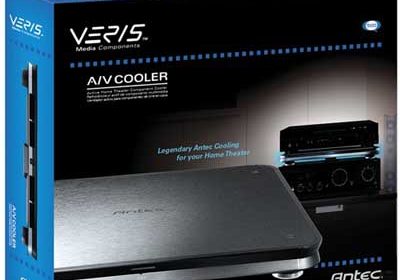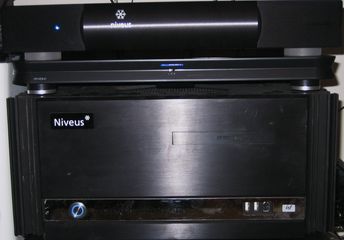Antec A/V Cooler

Antec has been known for years as being a great company to provide quality cases and power supplies, which are as great for gamers as they are quiet for Media Center users. They have come to embrace the Home Theater PC audience slowly, but have developed a product line dubbed "Veris ," which they’ve tied together their current HTPC offerings such as their Fusion and quiet hard drive enclosure, and now, the A/V Cooler. An odd addition, honestly, as it is the only Antec product I’m aware of which was not designed specifically for a computer. But I’m a computer guy, so you know I’m going to find some way to review this for you anyways. And at an MSRP over $100, it sure better perform as advertised!
Introduction
The invention of the A/V Cooler makes sense in that Antec has been
making devices to make computers quieter & cooler for years, so
it’s not that crazy to think their devices can cool A/V Components as
well. Here’s what Antec says about it:
Your home stereo equipment generates a lot of heat, whether it be your tuner, your amp, your CD changer or your DVD
player. That’s why Antec brings you the A/V cooler, the perfect device for cooling all your home audio/video equipment.
Simply place it on top of your hottest stereo component and let the two speed blowers cool your component while
preventing heat from rising to any components you choose to stack on top of the A/V cooler. The sturdy carbon-glass
structure with aluminum top deck is the perfect platform for stacking other audio/video components on. Keep your
equipment running cool, with the VERIS™ A/V cooler!Rated Voltage DC 12V
Operating Voltage 12V±10%
Speed Control High Low
Air Flow 8.0 CFM 5.5 CFM
Static Pressure 2.532mm-H2O 1.424mm-H2O
Input Current (White Led) 0.42A 0.30A
Speed 1600±10%RPM 1200±200RPM
Acoustical Noise 28.7dBA 22.45dBA
Input Power
Dimensions
Weight 4.4lbs / 2kg
1.8”(H) x 14.2”(W) x 16.9”(D)
So judging by the specs, it’s not that bad at low speed, and even at
the high speed it’s still under 29dbA for noise. To be fair, I don’t
have the proper equipment to do an official sound test, so I’ll have to
take their word on it. Now onto the tests!
So as I did not have any stereo equipment, nor any temperature
measuring device, I had to get a little creative on how I was going to
properly test this device. So I began thinking, and the Niveus Media
Centers came into mind, specifically the Denali chassis which is 100%
passively cooled, with heatsinks on the side. In addition to the
Denali, I’ve also stacked one of their NDCR Cable Card Receivers on top
of the Denali, which they aren’t the coolest things in the world
either. Using a computer allowed me both to do this review, and more
importantly, to have a method of testing the A/V Cooler.

As you can see, it’s quite a stylish design, and blends in perfectly with the black components I have. Here’s the system specifications of the Denalli LE system:
- Intel Core2 Duo E6700 CPU
- Seagate 750gb 7200rpm Hard Drive
- Nvidia Geforce 7600GT
- 2gb DDR2 Memory
- HD-DVD Drive
- Silent Power Supply
- Intel 975 Motherboard
The Denali in particular really is the ideal device to test the performance of the A/V Cooler, as its vents on the top, and zero fans inside mean that the air is going nowhere but upwards. So how does it perform?
Testing
Idling, the Denali does not get very hot to the touch, so that’s
something I had to change to really test out the A/V Cooler. I ran Everest Ultimate Edition on the
system, using their System Stability Test to get the system to as hot
as possible. I was able to get the system to around 55 degrees Celsius,
and then it was time to see if the A/V Cooler had any impact on it.
Additionally, touching the side heatsinks was very hot to the touch. So here are the temperatures with a full system load: Motherboard (56), CPU (65), DIMM (53), GPU (52), Hard Drive (45).
Now onto the challenge, I put the A/V Cooler on top of the Denali, in between the system and the CableCard receiver, and kept the system going 100% load. And I must say, the results were better than I expected: Motherboard (51), CPU (61), DIMM (49), GPU (48), Hard Drive (43).
In this environment system, noise is critical. Since the Niveus Denali LE is completely passively cooled, the only thing you hear around it is the hard drive. Even on the high fan setting, I’m pleased to report that the Cooler is VERY quiet, as advertised. On the LOW fan setting, the fans are barely audible unless getting right up to it. And temperatures were respectable as well: Motherboard (54), CPU (63), DIMM (51), GPU (50), Hard Drive (43).

Conclusion
Overall, the product works as advertised. Even on a computer system, the ventilation technique worked wonderfully. It should be noted, however, that the Denali chassis is pretty ideal for the A/V Cooler as it has ventilation ports on the top. If you plan on investing in this device for your HTPC chassis or receiver, make sure that it has ventilation ports at the top, otherwise, it probably won’t have much impact. I would anticipate similar results on any home theater components assuming the ventilation draws the heat up.
Is the cooler worth $100? It’s tough to say, but the results are clear. As you can see by the graph, on the high setting my CPU temperature dropped by 4 degrees which is pretty substantial when you talking about a thousand plus dollar piece of equipment. In this day and age of everyone trying to obtain the quietest systems while still maintaining temperatures, this is a nice alternative to the other steps which involve a LOT more effort.
Pros:
- Stylish, sleek design perfectly matches many A/V Components
- Near silent operation
- Sturdy design
- Low & High Fan Speed setting front-accessible
Cons:
- Only available in black
- $120 MSRP is steep
If you’ve got some hot stereo components, or a hot HTPC chassis, the A/V Cooler is a nice addition which is sure to cool it down.
Special thanks to Antec for providing the hardware necessary for doing this review!
